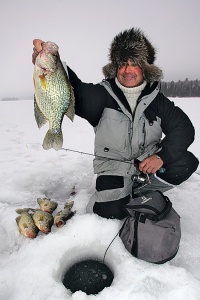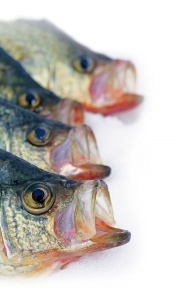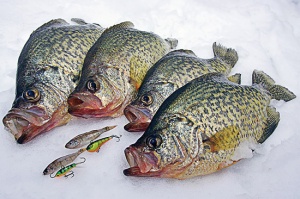 Sometimes it makes sense to match-the-hatch for winter crappie. A fine example is using an artificial bait that mirrors the size, shape, and color of the forage that fish are eating. But always treat this as a guideline, never as a rigid rule.
Sometimes it makes sense to match-the-hatch for winter crappie. A fine example is using an artificial bait that mirrors the size, shape, and color of the forage that fish are eating. But always treat this as a guideline, never as a rigid rule.
For instance, late last winter In-Fisherman Editor In Chief Doug Stange and Editor-Photographer Jeff Simpson met up with me to film an In?Fisherman television segment on a large, deep, clear, natural crappie lake. I’d kept close tabs on the fish for several weeks prior to their arrival and had harvested a few for dinner.
When I filleted the crappies, I closely examined their stomach contents. Young-of-the-year perch—about half the size of your smallest finger—were the most abundant item. Soft, gray insect larvae (likely mayfly) came in a distant second. As I landed several fish, I also noted them coughing up long, thin, threadlike bloodworms—chironomid larvae. So, I pretty much knew what was on their menu.
Had we been intent on matching-the-hatch, it would have made sense for us to tie on Jigging Raps or Salmo Chubby Darters painted in firetiger or perch pattern. Or to tip a small smoke-colored ice jig with one or two live wrigglers or maggots to mimic the mayfly larvae. A Genz worm dressed with a piece of red Gulp! Mini Earthworm, on the other hand, is the finest bloodworm imitation I’ve ever used. I have no doubt these presentations would have produced a few crappies. But our success would have been intermittent and the presentations a sad second-fiddle to what worked best.
It was a small white bucktail jig that looks like a young-of-the-year shiner, smelt, shad, or cisco. Despite the fact I had never once that winter come across any of these baitfish in the crappies’ stomachs, I knew a white jig was the ticket. I had tested it alongside other presentations and it never failed to produce two, three, four times as many fish.
 So, matching-the-hatch doesn’t work? Actually, it works marvelously. The lake we fished has a bountiful population of shiners, ciscoes, and whitefish. In the winter, the crappies in this particular lake frequent locations and habitat—large, 30-foot-deep mudflats—that put their preferred food item out of reach. So, being the opportunists they are, they feed on the forage that’s most plentiful and most available at the time. But that doesn’t mean they don’t have a preference.
So, matching-the-hatch doesn’t work? Actually, it works marvelously. The lake we fished has a bountiful population of shiners, ciscoes, and whitefish. In the winter, the crappies in this particular lake frequent locations and habitat—large, 30-foot-deep mudflats—that put their preferred food item out of reach. So, being the opportunists they are, they feed on the forage that’s most plentiful and most available at the time. But that doesn’t mean they don’t have a preference.
The white-jig strategy likely had worked because at other times of the year, crappies are accustomed to eating young-of-the-year ciscoes as well as emerald and spottailed shiners. In other lakes, however, the crappies might prefer an entirely different forage—bluegills, pumpkinseeds, perch, or perhaps a certain insect larva or crustacean. Whatever the case, it pays to know the complete list of what’s available throughout the year on any given body of water. Then experiment with different dietary items in terms of winter presentations to discover what the crappies prefer.
Sometimes the preferred winter forage is also the most abundant. Case in point: About 800 yards from the water we fished is another superb crappie lake. Silvery forage in the form of smelt, ciscoes, whitefish, and shiners is scarce to nonexistent in this much shallower, weedier, dingier body of water. Not surprisingly, the crappies react to the white jig in a nonchalant, ho-hum, take-it-or-leave-it manner. Yet, they go crazy when they spot a much gaudier jig dressed with yellow, red, orange, and blue craft hair that resembles a yellow perch or red-sided dace.
To view this article in its entirety please visit http://www.in-fisherman.com/2014/02/26/winter-crappie-forage-tactics/?utm_source=ENL-IFS&utm_medium=email&utm_campaign=Daily+Newsletters

Author: GORD PYZER, @GordPyzer on Twitter
*In-Fisherman Field Editor Gord Pyzer, Kenora, Ontario, has written many award-winning articles for -In?Fisherman publications. He’s an exceptional angler and fishery scientist who also appears on In?Fisherman television.
Source: In-Fisherman